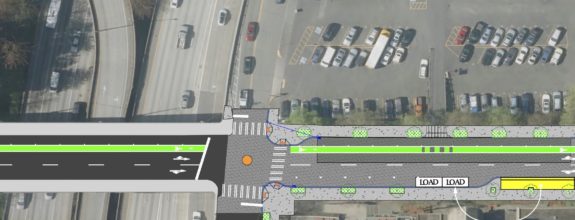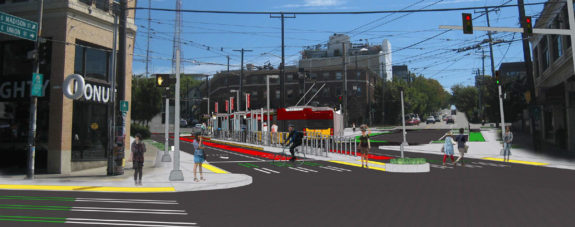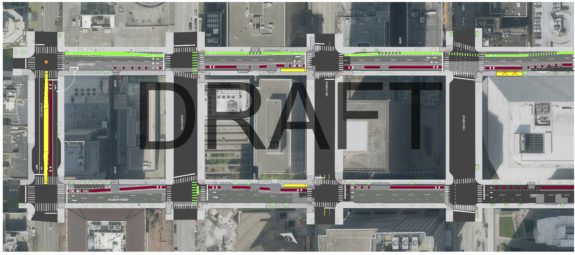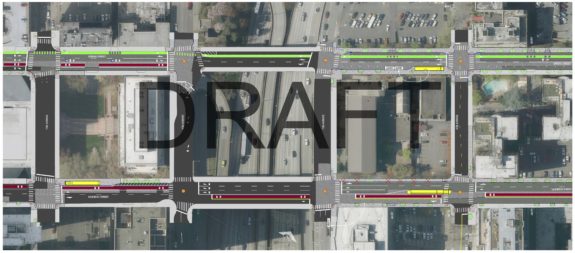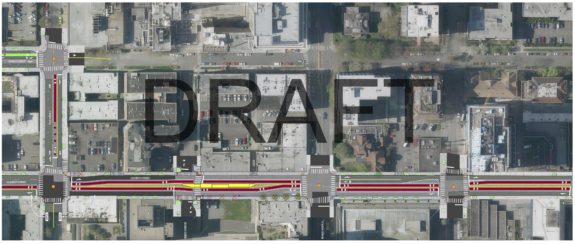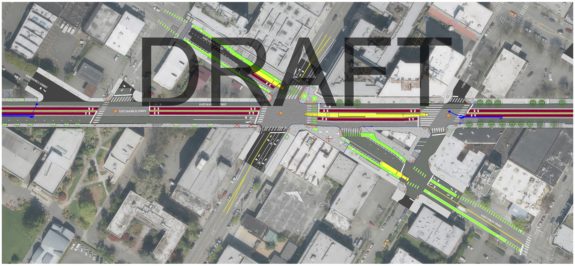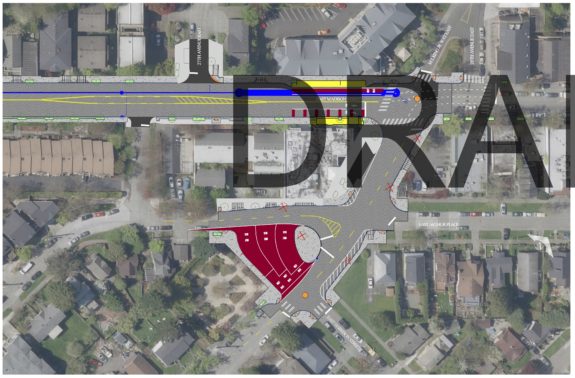Madison BRT project cuts nearly all of its bike route plans
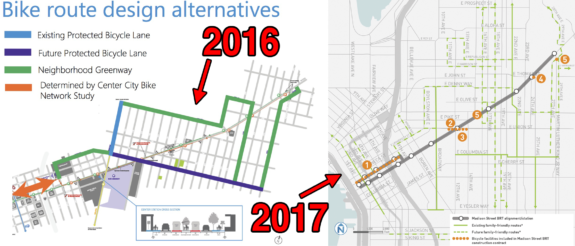
The bike route plans have gone missing.
The Madison BRT project has dropped its goal of designing a so-called "parallel" bike route to accompany its $120 million plans for a faster and more reliable bus line from the waterfront to MLK Way.
But just as concerning, the few short, disconnected sections of bike facilities that are planned mostly fail to meet standards that would make them inviting for people of all ages and abilities to use.
You can learn more about the plans and provide feedback at a Wednesday open house or through an online open house. From the project info page:
Spring Street door zone bike lane, missing westbound laneWednesday, March 15
5:30 - 7:30 PM
First African Methodist Episcopal Church
1522 14th AveONLINE
MARCH 8-22
Give feedback online!
MadisonStreetBRT.participate.online
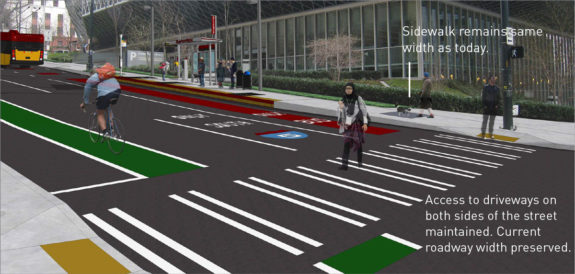
Without a layer of protection, this bike lane will constantly be blocked by stopped cars and delivery trucks.
The plans for Spring Street are better than they were a few months ago, but that was a pretty low bar. In August, the project team presented plans (PDF) that would build a one-way protected bike lane eastbound on Spring from 2nd to 4th Avenues that then turned into sharrows (!) for the busy uphill stretch crossing I-5.
The latest design swaps out the sharrows for painted bike lanes, which is an improvement over the dismal August design. But the lanes are as skinny as possible and either located squarely in the door zone of parked cars or are unprotected from incursions by stopped cars or delivery trucks. There are also no plans for separating people biking from people making turns at intersections, a major cause of injury and death for people biking:
The official excuse for not including bike lanes all the way across I-5 - this is one of the very few bike route opportunities for crossing the freeway between downtown and First Hill - is that "there is not enough right-of-way." But, of course, it's not a matter of right-of-way, it's a matter of priorities. The street is the same width east of 4th as it is west of 4th, there are just other uses that planners care about more.
A quality bike route along this stretch of Spring is within reach, but only if the city makes it a priority. If they don't then the bike lane is doomed to be uncomfortable and potentially dangerous, which in turn will lead to low use. If people can't depend on these bike routes to be safe and clear, then they can't depend on biking as a mode of transportation.
The eastbound Spring Street bike lane has some issues, but at least it exists. The latest designs have no westbound bike lane between First Hill and downtown. The 2016 map of proposed bike routes clearly shows an arrow pointing in both directions, so the removal of a westbound bike lane is a major cut.
As with any other mode of transportation, people need to bike in both directions. Building small, disconnected pieces of the bike network is going to get middling results at a time when the city is growing and we need serious results. That's the eventual plan, according to SDOT.
"The center city bike network is currently under study," said SDOT staff via email. "We are holding stakeholder meetings and community briefings to prioritize the locations and types of facilities for the Center City. Our vision for the center city bike network includes east-west connections between downtown and First Hill, Capitol Hill, and the Central District."
But this Madison project is happening now, investing $120 million in this particular corridor. There is not going to be a better time to build this connection.
SDOT's Madison BRT team has been studying the corridor extensively at far closer detail than the Center City Bike Network or One Center City plans could, and bike connections here have been part of this project's extensive public outreach all along. Booting one half of the bike lanes onto a separate public process is an insult to the many people who have been engaged with Madison BRT for two years now, volunteering their time to go to project meetings and provide public comment consistently noting the need for this bike connection.
People need a safe and comfortable way to bike between downtown and First Hill. This high-budget project all but promised to help make that happen. SDOT needs to stop making excuses and deliver a bike route people can use in both directions.
Options for Spring Street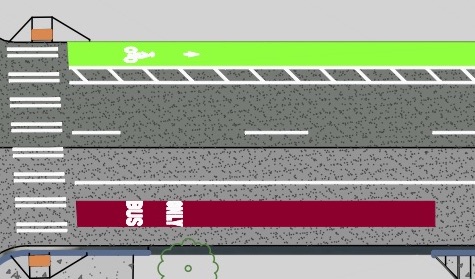
Plans for Spring between 2nd and 3rd. One option would be to just keep this going all the way to First Hill.
One option to make the downtown-First Hill connection would be to design the Spring Street section east of 4th like the existing plans west of 4th. Move the bike lane to the curb for the whole length between 1st and 9th Avenues, add a layer of protection (curb, paint and plastic posts, flower planters, something), and make sure intersections protect people biking from people in cars turning. A westbound lane would then need to be planned, likely on Seneca Street (connecting directly to University Street Station, which is a nice plus).
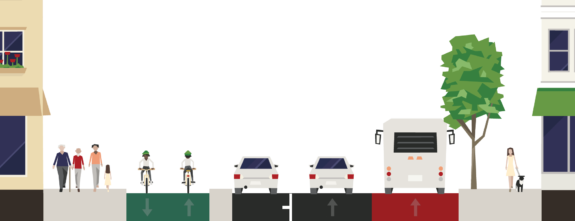
Spring Street looking east. Concept created using StreetMix.
Another option would be to prioritize safety, business access, public space and loading/valet zones. If there were only one general purpose lane, there would be ample space for a high-quality bike lane (perhaps two-way), loading/valet zones, on-street parking, parklets or whatever else the city can think to add. The bike lane could be raised to sidewalk level at hotel valet stops and other loading zones, making it easy and accessible for guests and deliveries. We already have an example of this on 2nd Ave that works fairly well.
Yet another option would be a two-way bike lane on Seneca instead of Spring, but I am hesitant to even suggest it for fear that the Madison BRT team would use it as a convenient excuse to cut its funding by declaring it "outside the scope" of their project. Because that's exactly what has happened to nearly all the other bike elements in the plan.
University Street and Denny Way GreenwaysThe Madison BRT project will fund "early design of the complementary greenway network going east-west from First Hill to Madison Valley," according to SDOT. Earlier designs suggested this would consist of a neighborhood greenway on University Street from 9th Ave to Union, a neighborhood greenway on Denny Way from Broadway to the existing greenway on 22nd Ave, and a new greenway on 24th that would cross Madison and connect to bike lanes on Union Street.
There is no parallel route to Madison east of Broadway because the street cuts across the grid. But neighborhood safe streets advocates were excited by the possibility of getting these neighborhood greenway and bike lane projects moving as part of this process. They aren't as direct as bike lanes on Madison, but they are still good connections on their own.
But as you will see, both the 24th Ave crossing and the Union Street bike lanes have been cut.
For the segments of bike lanes and neighborhood greenways that haven't been cut (yet), there is much more this project could do to make sure they connect to the project area on Madison. For example, how will the new bike lanes to First Hill connect along 9th Ave for the two blocks to University? How will the University Street Greenway connect to the Broadway Bikeway and the redesigned 12th/Union/Madison intersection?
Those kinds of connections should be within this project scope.
More biking and walking connections needed at "The Bottleneck"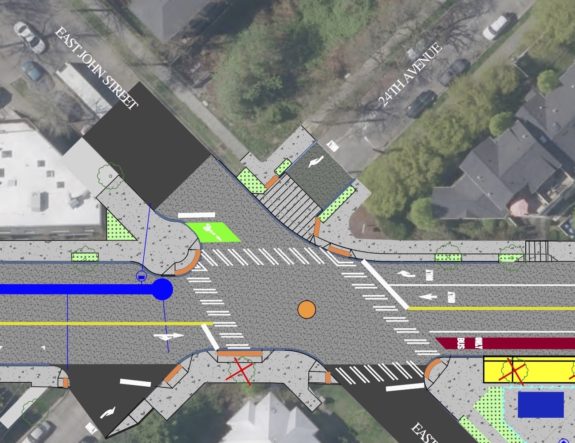 The BottleNeck Lounge is a fantastic watering hole named after the ridiculous intersection of Madison/John/24th nearby (or so I've always assumed). The Madison BRT project has the chance to finally make that intersection work better, especially for people biking and walking.
The BottleNeck Lounge is a fantastic watering hole named after the ridiculous intersection of Madison/John/24th nearby (or so I've always assumed). The Madison BRT project has the chance to finally make that intersection work better, especially for people biking and walking.
Today, it is truly awful to navigate by any mode. But if you have any kind of mobility challenge, it's nearly impossible. Curb cuts are mostly missing, crosswalks are confusing and steep grades make all this harder to deal with.
An already low-traffic street, 24th Ave was, at least until recently, proposed as a neighborhood greenway route. Whether it's a useful greenway for the citywide bike network is maybe up for debate, but the neighborhood desire to safely and easily cross Madison and John on foot and bike is very clear.
Current plans do include some widened sidewalks and better curb cuts, which is great. But people biking on 24th will be routed across two crosswalks and onto the sidewalk for a stretch rather than being able to cross directly. Routing people onto the sidewalk is not best practices, and a project of this scope and budget should be able to do better.
The design seems so close to making this direct connection, but right now it has stopped just short of making it work.
"To provide the required space for those biking and walking to cross this large intersection directly, the stop lines in both directions would have to move back significantly and would hinder the overall safety and efficiency of the intersection," said SDOT via email. In other words, creating a clear and usable bike crossing isn't a priority, so they cut it.
Union Street has been dropped entirely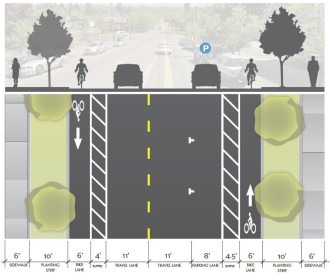
One of two designs planners proposed for Union Street bike lanes.
This brings us to the most disappointing part of this project update: Protected bike lanes on Union Street have been dropped entirely. I don't mean they have just been dropped from the funding - which is disappointing enough - they have been completely removed from even the pool of projects that could get added if the city finds extra grant funding.
Union Street bike lanes were the most exciting part of this project, so this is a devastating cut. Before the Move Seattle levy vote, the city even had competing design concepts for Union, and the team asked people for feedback on their preferred option. The message was that mutimodal transportation projects would be truly multimodal under the Move Seattle. So much for that.
"Through the planning and outreach process for Union St PBLs, we heard community concerns about pedestrian safety at crossings, parking removal for businesses and residents, the importance of maintaining transit service and stops for the Route 2, which would require bus islands to accommodate PBLs, and a strong interest in undertaking a holistic review of transportation needs along the Union St corridor," said SDOT staff in a email.
Complete streets and well-designed bike lanes improve safety for people walking, and SDOT damn well knows this. They also know how to build bus islands. These are terrible excuses. If this project wants to fund that "holistic review," then that would at least be something. Instead, the team decided to just cut the biggest piece of bike infrastructure associated with their project even though this cut makes their stated goal of creating a "parallel" bike route impossible.
12th/Madison/Union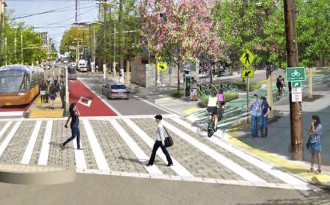
The previous design as of 2015.
Perhaps the trickiest part of this entire route is the mess where 12th Ave, Madison and Union all converge. It's also the spot where this project can make the biggest positive impact.
Today, it's a mess for everyone. There's no clear path for someone on a bike to access the Union Street bike lanes, bike lanes on 12th Ave disappear just before reaching this stressful spot (where they are needed most), and people in cars trying to make left turns have a horrible time resulting in many collisions and near misses.
The latest design has some good ideas, including banning many left turns, extending sidewalks and making Union between 11th and 12th bus and bike only.
A previous design for this intersection even became something of a poster child for the Move Seattle levy vote. It wasn't perfect, but it included some separated spaces for people biking and people walking, and it communicated that the city can design its streets to accommodate all modes.
Well forget that. The project team has gotten rid of the separated bike connections. Under the new design, bike lanes will simply end before the intersection, dumping everyone biking onto busy sidewalks where they can try to navigate through crowds of people walking.
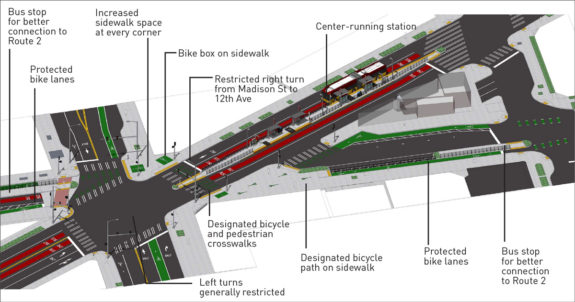 The 12th Ave bike lanes will not be protected, and there's no clear way for people using those lanes will make left turns onto Union (especially if the sidewalks are crowded or they are riding increasingly-popular big family bikes that can't be turned on a dime).
The 12th Ave bike lanes will not be protected, and there's no clear way for people using those lanes will make left turns onto Union (especially if the sidewalks are crowded or they are riding increasingly-popular big family bikes that can't be turned on a dime).
People biking on Union will have to cross in two stages, one of which involves weaving through people on the sidewalk in front of Mighty O. This might not seem like a big deal if there are only one or two people biking through at a time, but what happens when this becomes a more popular bike route as called for in the city's Bicycle Master Plan?
Designing this intersection is difficult, I know, but the latest concept is the traffic engineering equivalent of giving up. What they really want is for people on bikes to disappear 100 feet before the intersection and magically reappear on the other side, but that isn't going to happen. Painting some green squares on the sidewalk is not a solution.
The latest design would be better than today, but that is a very low bar. This design is not built to handle much growth in biking and walking numbers, which is all but inevitable given all the development in the area, increased use of this bus stop and city plans to increase biking.
If this were a low-budget safety project, I could see this being a good design compromise. But this is the centerpiece intersection for a $120 million project. The design needs to fix this intersection once and for all. It's not there yet.
A disappointing visionThanks for reading this long and mostly negative post. I really wanted to write a happy post because I am very excited about bus rapid transit on Madison. When this project kicked off on 2015, I wanted to believe SDOT was serious when they talked about this project as a multimodal remake of the Madison corridor that would "advance the design of one east - west bicycle facility that generally connects the same neighborhoods as the Madison Street corridor" and would "provide a better bike connection to the Madison corridor, while offering comfortable connections along the corridor for people of all ages and abilities" as the initial outreach materials said. Because of that, I was a major supporter of this project.
But SDOT has failed to back up those words with design and funding, and the agency deceived safe streets supporters in the process.
I had so much hope for this project when it started that it's just really devastating to see bike safety and connectivity discarded at every possible step. Seattle leaders give so much lip service to biking and multimodal transportation, but here they have $120 million to work with and they still cut every bike element that poses even the slightest challenge.
Bike safety and access is this project's lowest priority. They are willing to squeeze little pieces of bike lane in where it's easy, but that's it.
And neighbors now know they can't trust project planners when they promise "parallel" bike routes to so-called multimodal projects. Those parallel routes will just be cut out later in the process. I hope Delridge neighbors are paying attention, because you're next.
The cynic in me says that Move Seattle passed, so city leaders don't need to pretend to care about building a bike network anymore. It's the same thing that happened to the downtown bike plan. Before the vote (which engaged bike advocates worked very hard to help pass), plans were glorious. After the vote, everything except the easiest, tiniest things got cut.
This vision will never create a connected bike network that people of all ages and abilities can use to get around town. But engaged neighbors who believe in that vision aren't going to give up or go away. The city is prepared to make its residents fight tooth and nail for every inch of that safe bike network. And people will.
Here are the latest block-by-block designs for the Madison BRT project:
